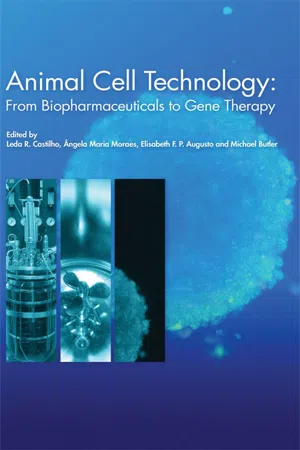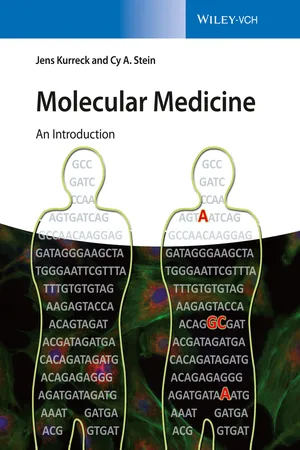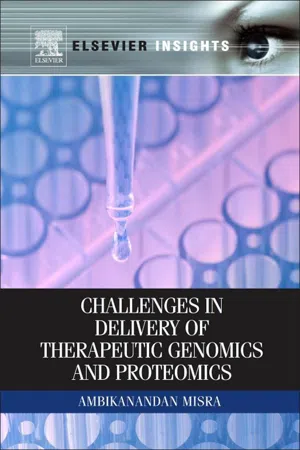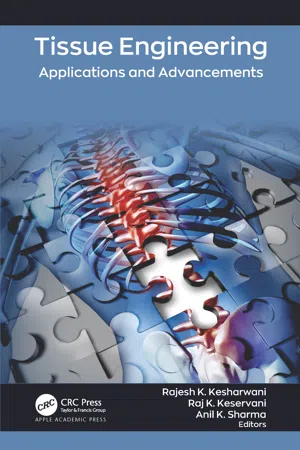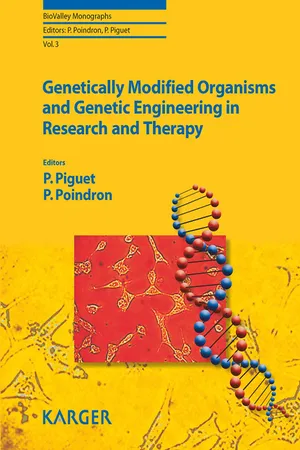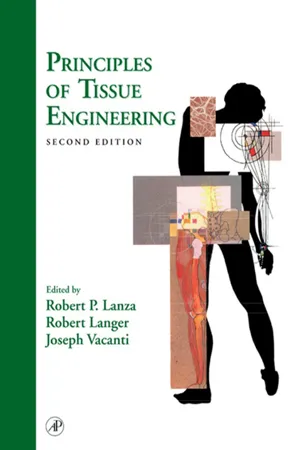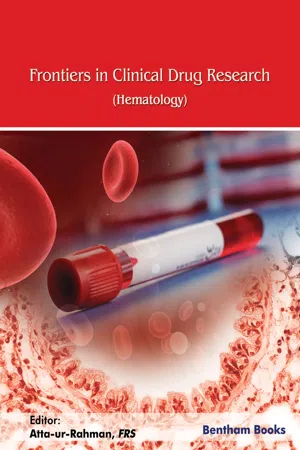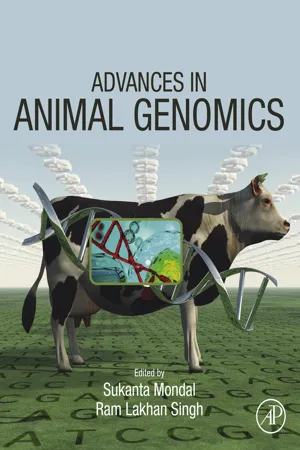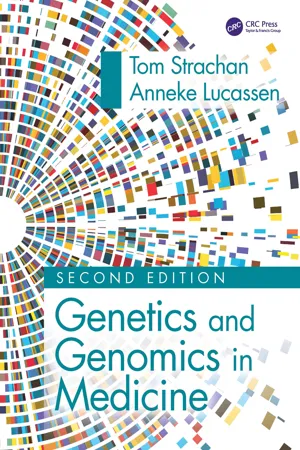Biological Sciences
Gene Therapy
Gene therapy is a technique that involves introducing genetic material into a patient's cells to treat or prevent disease. This can be achieved by replacing a faulty gene with a healthy one, inactivating a malfunctioning gene, or introducing a new gene to help the body fight a disease. Gene therapy holds promise for treating a wide range of genetic disorders and other diseases.
Written by Perlego with AI-assistance
Related key terms
12 Key excerpts on "Gene Therapy"
- eBook - ePub
- Tiago G. Fernandes, M. Margardia Diogo, Joaquim M.S. Cabral(Authors)
- 2019(Publication Date)
- Academic Press(Publisher)
More recently, methods of gene introduction, regulation, and editing have been the focus of promising therapeutic mechanisms in biomedical and pharmacological research endeavors. The formal definition of Gene Therapy, as defined by the National Institutes of Health (NIH), is the use of genes to treat or prevent disease [1]. Gene Therapy can take many forms, such as replacing a mutated gene with a healthy copy, inactivating a mutated gene, or introducing a new gene into the body to help fight disease [1]. Gene therapies introduce foreign nucleic acid sequences to cells, which then can interact with the cell’s transcriptional and translational machinery to produce delivered nucleic acids or proteins. Due to the broad spectrum of potential disease targets and the ever-growing libraries of modular genes cassettes documented, gene therapies have been continuously investigated for treatment applications for decades. Historically, the first Gene Therapy clinical trial started in 1989, but early devastating complications regarding the safety of gene therapies slowed progress in the field [2]. These past failures motivated the need for better Gene Therapy designs for clinical application [2]. Several factors were addressed, ranging from the design of vectors themselves to the methods of their delivery to control spatiotemporal presence of therapeutic gene cassettes in target cell populations [3]. After over 2500 clinical trials and almost 30 years, the first five gene therapies were approved by the Food and Drug Administration (FDA) between the years 2015 and 2019 [2]. Gene therapies present many features, such as localizing therapeutic levels of biomolecules, that make them desirable when compared to traditional systemic therapeutic options for tissue regeneration and disease treatment - eBook - ePub
Animal Cell Technology
From Biopharmaceuticals to Gene Therapy
- Leda Castilho, Angela Moraes, Elisabeth Augusto, Mike Butler(Authors)
- 2008(Publication Date)
- Taylor & Francis(Publisher)
With the advent of new knowledge in cell and molecular biology, it has become evident that the causes of many human diseases are related to changes in genes. Genes represent the starting point for all events that subsequently lead to changes in expression of proteins in cells. Protein function determines, in turn, the cell phenotype and cell function. When genes are changed in such a way that the proteins encoded by them are unable to perform their normal function, a genetic disorder may occur. The cumulative effect of events triggered by atypical or defective genes in an organ leads to the disease phenotype. Gene Therapy is a technique used to correct genetic defects that may cause the development of diseases, and consists of blocking an undesirably activated gene, or correcting or replacing the defective gene with a normal gene (Figure 21.1). The diseases primarily targeted by human Gene Therapy are monogenic, that is, those caused by defects in a single gene (Anderson, 1998). Since the 1990s, the development of DNA vaccines has led to the concept of Gene Therapy being extended to prophylaxis and treatment of infectious diseases (Brun-nell and Morgan, 1998).The first step in Gene Therapy is to identify the gene causing the problem. Then the appropriate genetic material is introduced into the target cells, with the aim of correcting the problem. Two main strategies are used: (i) in vivo therapy, in which the genetic material is introduced directly into the individual by a systemic route, or when possible, at a specific site; (ii) ex vivo therapy, in which the target cells are treated withthe gene product outside the individual. The cells are expanded and then transferred back to the patient (Figure 21.2 ).Figure 21.1 In a normal cell, genes are transcribed into messenger RNA (mRNA), and thereafter, translated into proteins with specific functions (A). When the gene responsible for encoding a protein has a defect, this may cause the translation of a defective protein, unable to perform its function and leading to a disease (B). Gene Therapy aims to rectify the defect, by blocking, correcting, or replacing the gene.The key to successful in vivo Gene Therapy is the transfer of the genetic material to the target cells or tissues and the effective expression of the gene in question. However, this is a complex process, requiring several barriers to be overcome. Ex vivo Gene Therapy involves the transfer of genes to cells maintained in culture and their subsequent transplantation to the target tissue. The cells to be transfected must be available in large amounts, have a long life after transfer to the host, express the gene of interest for a long time period, and not trigger any kind of immune response. The advantages of ex vivo therapy include the possibility of characterizing the modified cell population before transfer. This makes it easier to introduce the genetic material into the cells and it can be insured that the clonal population of cells expresses a high amount of the product encoded by the transgene before transfer back into the patient. - eBook - ePub
Molecular Medicine
An Introduction
- Jens Kurreck, Cy Aaron Stein(Authors)
- 2015(Publication Date)
- Wiley-Blackwell(Publisher)
However, advances in vector technology are likely to overcome these obstacles in the near future. The term Gene Therapy refers to the transfer of genetic material into the cells of an individual's body with the intention of treating a disease. Classically, the affected patient carries a defective gene, the cause of the disease. The methods of molecular biology can be used to transfer the functional form of the gene to hopefully correct the defect (Figure 11.1). Examples of Gene Therapy include correction of metabolic functions, the replacement of missing blood coagulation factors, or the transfer of tumor suppressor genes for the treatment of cancer. In addition, Gene Therapy can be used to create cells with novel properties. For example, the body's own defense mechanisms against tumor cells can be triggered by the use of genes encoding cytokines. Genes for enzymes can be transferred, which convert the inactive precursor of a drug (prodrug) into the active form. DNA vaccination involves transferring viral genes, which trigger an immune response against the virus. Indeed, any transfer of nucleic acids designed to manipulate genes or to regulate gene expression may also be considered Gene Therapy. Examples also include antisense and RNA interference therapies, which will be addressed in Chapter 13. Fig. 11.1 Principles of Gene Therapy. Due to a defective gene, a protein may not be produced in the cells of the affected patient. With the aid of vectors, the intact version of the gene can be introduced into these cells. Whether or not the therapeutic gene is integrated into the genome of the host or remains episomal is determined by the choice of vector. The functional gene can then be expressed so that the active protein is synthesized and the defect corrected - eBook - ePub
Methods and Applications of Statistics in Clinical Trials, Volume 1
Concepts, Principles, Trials, and Designs
- Narayanaswamy Balakrishnan, N. Balakrishnan(Authors)
- 2014(Publication Date)
- Wiley(Publisher)
Chapter 33 Gene Therapy Samantha L. Ginn and Ian E. Alexander 33.1 Introduction Gene Therapy is defined by the United Kingdom’s Gene Therapy Advisory Committee as “the deliberate introduction of genetic material into human somatic cells for therapeutic, prophylactic or diagnostic purposes” [1] and was conceived, originally, as an approach for the treatment of inherited monogenic diseases. Ongoing improvements in gene-transfer technologies and biosafety have been accompanied by a growing appreciation of the broader scope of Gene Therapy. Pathophysiological processes such as wound healing [2, 3], chronic pain [4] and inflammation [5, 6], cancer [7–9], and acquired infections such as HIV-1 [10] are now becoming realistic targets for this promising therapeutic modality. The first authorised gene transfer study took place at the National Institutes of Health (NIH) in 1989. In this marker study, tumor-infiltrating lymphocytes were harvested, genetically tagged using a 7-retroviral vector, and reinfused with the intention of examining the tumor-homing capacity of these cells. This landmark study provided the first direct evidence that human cells could be genetically modified and returned to a patient without harm [11]. Since then, over 1800 trials have been approved, initiated, or completed worldwide [12], with the majority being in the United States [13, 14]. Most studies have focused on cancer, with monogenic and cardiovascular diseases the next most frequent indications (Table 1). These predominantly early-phase trials have provided invaluable proof-of-concept for Gene Therapy by confirming that desired changes to the target cell phenotype can be achieved successfully. In most trials, however, an insufficient number of cells have been genetically modified to achieve therapeutic benefit - Ambikanandan Misra(Author)
- 2010(Publication Date)
- Elsevier(Publisher)
6 Applications of Gene Therapy Mukesh Kumar and Ambikanandan Misra Pharmacy Department, TIFAC – Centre of Relevance and Excellence in New Drug Delivery Systems, The Maharaja Sayajirao University of Baroda, PO Box 51, Kalabhavan, Vadodara 390 001, Gujarat, India 6.1 Gene Therapy A number of common human diseases have underlying genetic causes, and pharmacological approaches often fall short of curing many of these diseases. Gene Therapy is defined as the correction of dysfunctional or deleted genes by supplying the lacking component as a means to permanently treat or reverse such diseases [1]. Gene Therapy provides a unique approach that can be used in the treatment of both inherited and acquired diseases. Researchers in Gene Therapy have used one of the ways for correcting defective genes such as replacement of a nonfunctional gene with a normal gene, or an abnormal gene with a normal gene, through homologous recombination; or for repairing an abnormal gene through selective reverse mutation or selectively controlling expression of a defective gene [ 2, 3 ]. In another type of application, the genes may also be delivered as genetic vaccines to induce both cell-mediated and humoral immune responses. The fundamental principle underlining Gene Therapy is theoretically straightforward, but difficult to achieve in practice satisfactorily. The two essential components of gene medicine are therapeutic gene coding for a protein along with its expression regulatory component and the gene delivery system [4]. Many genes capable of correcting diseased phenotypes have been identified, and it is now possible to produce engineered DNA that carries a therapeutic gene in sufficient quantities for clinical trials. The simplified schematic general process of Gene Therapy is shown in Fig. 6.1. Initially, the required desired gene (or DNA-containing gene) is complexed, compacted, and packaged into a suitable vector, either viral or nonviral, to form the DNA–vector system- eBook - ePub
Tissue Engineering
Applications and Advancements
- Rajesh K. Kesharwani, Raj K. Keservani, Anil K. Sharma, Rajesh K. Kesharwani, Raj K. Keservani, Anil K. Sharma(Authors)
- 2022(Publication Date)
- Apple Academic Press(Publisher)
Indeed our genes define who we are, though sometimes a defect in the gene can produce an imperfection that can threaten the existence of an individual. In the last four decades, several genes have been identified that are responsible for different genetic disorders in human. A new field of biology has henceforth emerged called the Gene Therapy. Gene Therapy can, therefore, be defined as a method of treating diseases by either modifying the expressions of an individual’s genes or alteration of abnormal genes or introduction of a normal healthy gene. The field holds great promise for treating an extensive range of human diseases. It has been found to be successful especially in single-gene diseases such as sickle cell anemia, hemophilia, etc. However, the therapy is still in its infancy but it brings a new ray of hope for patients who are living with difficult and incurable diseases.3.6 PROCESS OF Gene Therapy
Gene Therapy can be described as the delivery of nucleic acid into the cells of patient to treat a disease. The nucleic acid here acts as a drug and tries to fix the genetic problem at the source. There are three ways that gene delivery can be performed.3.6.1 REPLACEMENT OF THE MUTATED GENE THAT IS RESPONSIBLE FOR THE DISEASE WITH ITS HEALTHY COPY
The process is more appropriately called gene augmentation wherein multiple copies of the desired gene are introduced in the cell through transfer vectors and made to express at high levels. However, this is successful only if the disease has not caused irreversible damage in the body, for example, the method has been successfully applied to correct cystic fibrosis (Figure 3.9 ).3.6.2 “KNOCKING OUT” OR INACTIVATING THE MUTATED GENE THAT IS FUNCTIONING IMPROPERLY
The process is also called “gene inhibition therapy” and is more suitable for treating infectious diseases, cancer (oncogene is inhibited), and certain inherited diseases (Figure 3.10 ).FIGURE 3.9 Gene replacement.Source: Adapted from https://www.yourgenome.org/facts/what-is-gene-therapy (https://creativecommons.org/licenses/by/4.0/ ).FIGURE 3.10 Gene inhibition.Source: Adapted from https://www.yourgenome.org/facts/what-is-gene-therapy (https://creativecommons.org/licenses/by/4.0/ ).3.6.3 INTRODUCTION OFA NEW GENE INTO THE BODY THAT CAN HELP TO FIGHT THE DISEASE
Gene Therapy needs not always aim at replacing a defective gene or suppressing its function, but sometimes a different gene is introduced that can affect the peripheral or epigenetic function of the defective gene. For example, one may not correct or suppress the oncogene rather introduce another gene that has tumor suppressing function such as introducing cytokine gene into tumor cells (Figure 3.11 - P. Piguet, P. Poindron(Authors)
- 2012(Publication Date)
- S. Karger(Publisher)
3 ]. It was first conceived as a treatment for hereditary single-gene defects, but gene replacement or repair can bring permanent relief in a number of other disorders. Therefore, Gene Therapy is also being developed for (1) acquired diseases such as cancer, (2) cardiovascular diseases, or (3) neurodegenerative disorders including Alzheimer’s, Parkinson’s and Huntington’s diseases, and (4) infectious diseases. In the future, Gene Therapy approach may allow doctors to treat a disorder by inserting a gene into a patient’s cells instead of using drugs or surgery.Although Gene Therapy is a promising treatment strategy for a number of diseases, it is still considered an experimental strategy and the technique remains risky and is still under study to assess its safety and effectiveness. Gene Therapy is currently only being tested for the treatment of diseases at an advanced stage that have no other cure.What Is Gene Therapy?
The science of Gene Therapy relies on the introduction of genes to cure a defect or slow down the progression of a disease and thereby improve the quality of life. Today, Gene Therapy is still considered an experimental strategy. But, its extraordinary evolution suggests that in the near future, this approach may allow doctors to treat a disorder by inserting a gene into patient’s cells instead of using conventional drugs or surgery.Researchers actively study and test several options for Gene Therapy applications, including: – Replacing a mutated gene that causes disease with a healthy copy of the corresponding gene. – Inactivating, or ‘knocking out’, a mutated gene that is functioning improperly. – Introducing a new gene into the body to help fight a disease.During the last decades, intensive research in the area of Gene Therapy has been conducted worldwide with the first approved Gene Therapy clinical trial in 1990. In this study, the adenosine deaminase (ADA) gene was transferred into T cells of two children with severe combined immunodeficiency (ADA-SCID) [4 ].Several hundred clinical studies in Gene Therapy have now been performed. These trials have shown that there are still several major factors that prevent Gene Therapy from becoming a routine way to treat genetic conditions and disorders. Cancer Gene Therapy represents one of the most rapidly developing areas in pre-clinical and clinical cancer research. However, some problems need to be solved before this strategy becomes routinely adopted in clinic. Two of the most important problems are low efficiency of gene transfer and lack of selectivity of the existing vectors.- eBook - ePub
- Robert Lanza, Robert Langer, Joseph P. Vacanti(Authors)
- 2000(Publication Date)
- Academic Press(Publisher)
Part VIII Gene Therapy CHAPTER 30 GENE-BASED THERAPEUTICS Lee G. Fradkin, J. Dezz Ropp and John F. Warner INTRODUCTION Many inherited and acquired disease processes, characterized at the genetic level, are known to be due to protein deficiencies or defects. Potential gene-based therapeutic strategies can now be designed to address these diseases. The initial premise of Gene Therapy was to correct heritable genetic disorders through gene replacement. However, the true potential of gene-based therapies can now be viewed in a broader context of biologics delivery for applications involving cancer, vaccines, genetic and metabolic disorders, viral infections, as well as cardiovascular and other organ-based interventions. The basic goal of gene-based therapeutics is the safe and effective delivery of genes to the disease site with subsequent expression, under physiologic conditions, of a therapeutic protein. Biotechnology, in existence for approximately two decades, has traditionally focused on the production of therapeutic proteins. This industry was formed on the concept that synthetic (i.e., in vitro) manufacture of therapeutic proteins offers safety, control, and cost savings over isolation from natural sources. The diverse biologic activities provided by therapeutic proteins present great opportunities for the treatment of disease. Despite the immense advances in this field, the individual qualities of recombinant therapeutic proteins also present obstacles in their development, manufacture, and utilization. The concept of gene-based therapeutics arises from a desire to minimize the complexity presented by utilizing protein as the delivered therapeutic and to capitalize, instead, on the manufacture and delivery of a more generic molecule, namely, DNA encoding the therapeutic protein - Atta-ur-Rahman(Author)
- 2020(Publication Date)
- Bentham Science Publishers(Publisher)
i.e. haemophilia, β-haemoglobinopathies, leukaemia, lymphoma and other haematologic. Results from some clinical trials indicate that Gene Therapy can cure or improve many inherited or acquired hematologic disorders. It has the potential to improve the quality of life of those patients who are fully dependent on life-long parenteral therapy with recombinant proteins or blood and its products. However, the increased knowledge about the biological basis of the haematological disorders is associated with important advances in therapeutic management prevention of new cases. In this chapter, the current status of Gene Therapy will be reviewed with a focus on recent technologies such as gene delivery vectors, CRISPR genome editing technology, and CAR T-cell therapy, and their applications in the treatment of various blood disorders, in addition to the demonstrations of the outcomes of selected clinical studies, followed by a summary of the current challenges to Gene Therapy and future outlook.Keywords: β-haemoglobinopathies, CAR T-cell therapy, CRISPR genome editing technology, Gene delivery vectors, Genetic disorders, Gene Therapy, Haematological disorders, Haemophilia, Leukaemia, Lymphoma.* Corresponding author Anand Gaurav: Faculty of Pharmaceutical Sciences, UCSI University, No. 1, UCSI Heights, Jalan Menara Gading, Taman Connaught, 56000 Kuala Lumpur, Federal Territory of Kuala Lumpur, Malaysia; E-mail: [email protected]INTRODUCTION
Gene Therapy is one of the products of rapid development in the field of genomics. It involves the use of experimental techniques that use genes for therapeutic purposes and disease prevention. The application of these techniques has allowed doctors to treat many disorders by inserting a gene into the cells of the patient rather than using drugs or surgery. In the past 15 years, researchers have developed different approaches to Gene Therapy. These approaches include 1) replacing the mutated gene that causes the disorder with a healthy copy of the gene. 2) knocking out or inactivating a mutated gene that is functioning incorrectly and introducing a new gene into the body to assist in combating the disease [1 - 4 ]. Even though Gene Therapy has proven to be an effective therapeutic approach for a number of diseases i.e. certain types of cancers, viral infections and inherited disorders, the technique still carries significant risk and is still under study to confirm its safety and efficacy. At present, Gene Therapy has only been studied and developed for diseases that have no other cures. Many successful gene therapies have been developed, and the development has been most noticeable in the field of haematological diseases [5 - 7 ]. Haematological diseases primarily malignancies make up a major portion of the global disease burden [8 ]. There has been an increase in the mortality rates for all haematological malignancies since the beginning of the millennium except for Hodgkin's lymphoma [9 ]. The mortality rate due to leukaemia is considered the highest for all socio-demographic index countries, except for the lowest index countries [10 ]. Moreover, when adding the contribution of other haematological disorders i.e. haemolytic anaemias, haemoglobinopathies, maternal haemorrhage, etc. the haematological disorders contribute significantly to the global mortality and morbidity. There are no drugs that can cure haematological malignancies, thus there is a huge unmet medical need to develop therapies that can cure these disorders. There has been a trend over the years whereby Gene Therapy research has been focused primarily on haematological disorders [11 ]. The main reason behind this trend appears to be the ease with which individual cells exhibiting haematological problems can be isolated, as well as the comparative ease of access of the disease for detection and intervention compared to other diseases like solid tumours, cardiovascular and Central Nervous System (CNS) diseases [12 , 13 ]. For most of the hereditary diseases in haematology, the advance in the delivery system mainly the viral vector system for gene delivery has contributed significantly to the improved clinical outcomes with minimised genotoxicity [14- eBook - ePub
- Sukanta Mondal, Ram Lakhan Singh(Authors)
- 2020(Publication Date)
- Academic Press(Publisher)
Chapter 11: Gene Therapy
Deepti Saini Protein Design Pvt. Ltd, SID, Indian Institute of Science, Bangalore, Karnataka, IndiaAbstract
Genes, composed of DNA, are templates for protein production. The altering gene causes changes in proteins and leads to diseases. A viable method to treat these genetic diseases is Gene Therapy, involving vectors to transfer healthy genes into the patient. Viral vectors are transferred into host cells, where they alter the nuclear DNA. Somatic Gene Therapy involving the transfer of genes into somatic cells can also be done. Germline therapy, transfer of genes into germ cells, ensures that all alterations are heritable. In Gene Augmentation Technique, when cells contain nonfunctional DNA, functional DNA is inserted. In Gene Inhibition Therapy, a gene is inserted, which suppresses or overrides the faulty gene. Hurdles for Gene Therapy to be effective: Immune responses, multigenetic disorders, cost, short-lived natures, and side effects. There are ethical complications as to what is normal versus undesirable traits.Keywords
CRISPR Gene editing; Gene Therapy; Somatic and germline therapy; Viral and nonviral vectors11.1. Genes
Genes, segments of DNA present within the chromosomes of a cell, provide the code for conversion RNA into proteins, the functional and structural units of the human body. Hence, a gene is a template. These proteins determine the properties of our cells and their function, including the immune system. Genes can be altered through genetic mixing from parent to offspring, aging, and mutation. Genes are transmitted from parent to offspring, each parent providing one half of the set of total genes. This is the reason that traits such as hair and eye color are linked to genes, but defects in the genes can be transferred to the offspring. These lead to genetic diseases.A genetic disease is caused due to abnormalities in genetic makeup. The genetic abnormality can be from a discrete change in a single base in the DNA of a gene to an overall chromosomal abnormality involving the addition or subtraction of a single chromosome or a set. Some genetic disorders are inherited, while acquired mutations in a gene or group of genes may cause others. - eBook - ePub
Progress, Pioneers and Process
Studies in Physiology and Genetic Medicine
- Moyra Smith(Author)
- 2018(Publication Date)
- WSPC(Publisher)
Chapter 12 Gene Therapy, Antisense Therapy, and Gene Editing In this chapter, Gene Therapy, use of nucleotides in antisense therapy, and gene editing will each be discussed in separate sections. 12.1 Gene Therapy: Routes of Administration Gene Therapy is sometimes carried out using ex vivo transfer of the therapeutic gene to patients’ cells; these can include peripheral blood cells, often patient’s bone marrow stem cells are used. In some cases, Gene Therapy has been directly administered, for example through intravenous injection or intrathecal injection (see Fig. 12.1). 12.2 Viral Vectors for Gene Therapy Advances in Gene Therapy have developed through identification of causative gene defects associated with specific genetic diseases and through identification of treatment targets. In addition, suitable methods have been developed to introduce normal versions of the defective gene into specific cells in affected patients. Choudhury et al. (2016) reviewed progress in identifying suitable viral vectors to carry the corrective gene into cells and vectors that can be used to introduce inhibitory RNAs to target specific abnormal genes. Suitable vectors for delivery include adeno-associated viruses and specific lentiviral vectors. The adeno-associated viral vectors do not integrate into the host chromosomes. Lentiviral vectors used to carry genes do become integrated into host chromosomes. Fig. 12.1. Stem cell therapy and Gene Therapy. Choudhury et al. (2016, 2017) emphasized that the size of the transgene that can be inserted varies in different viral vectors. The maximum size of a transgene that can be inserted into an adeno-associated virus is 4.5 kb. The maximum transgene size that can be inserted into a lentiviral vector is 8.5 kb. Lentiviral vectors include gutted forms of the human immunodeficiency virus (HIV)-type viruses - eBook - ePub
- Tom Strachan, Anneke Lucassen(Authors)
- 2022(Publication Date)
- CRC Press(Publisher)
Chapter 10 . Here we focus on Gene Therapy for inherited disorders where the approach is to modify the disease cells genetically.Other Gene Therapy trials have been split almost equally between monogenic disorders, complex cardiovascular diseases, infectious diseases, and other categories. However, only 3 % of the listed trials are phase III trials, in which the efficacy of the therapy is tested on a large scale. Despite the limited number of trials, monogenic diseases have always been high on the Gene Therapy agenda, and the first definitive successes have been in that area.Multiple successes for ex vivo gene supplementation therapy targeted at hematopoietic stem cells
Successful ex vivo Gene Therapy trials have been carried out for various blood disorders and some storage disorders by targeting bone marrow cells or peripheral blood lymphocytes enriched for hematopoietic stem cells. Our blood cells are short-lived and need to be replaced by new cells derived from self-renewing hematopoietic stem cells. These cells, which are found mostly in the bone marrow (and to a smaller extent in peripheral blood), give rise to all of the many different types of blood cell and also to some tissue cells with immune functions (Figure 9.17 ).For some disorders treated in this way, alternative treatments have sometimes been used, but they are either very expensive or very risky (see below). For some blood disorders, treatment with purified gene product (such as recombinant proteins) is an option, but it is extremely expensive. Bone marrow transplantation has occasionally been used.
Learn about this page
Index pages curate the most relevant extracts from our library of academic textbooks. They’ve been created using an in-house natural language model (NLM), each adding context and meaning to key research topics.

